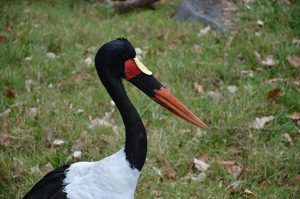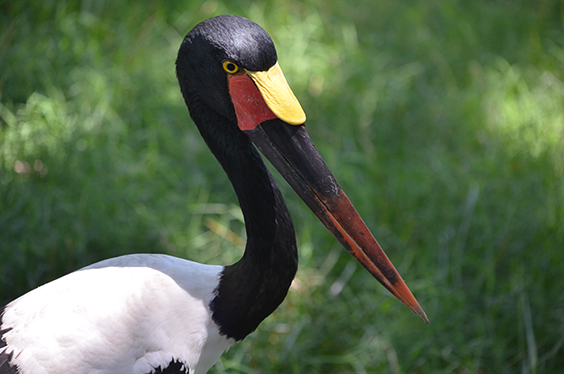Which two birds have the longest beaks here at the zoo? Find out in this Creature Feature about the Zoo’s two Saddle-billed Storks. The following interview is with Paula Blair, animal keeper at the Maryland Zoo for close to 7 years!

Paula, and her team of keepers, care for a large variety of species of animals at the Zoo, mainly including residents of the African Journey; Giraffe, Okapi, African Lion, Cheetah, Warthog, Demoiselle Crane, Kirks’ Dik Dik, Lesser Kudo, Addra Gazelle, Saddle-billed Storks, Ground Hornbill. Paula says that although they are birds, the Saddle-billed Storks have great personalities!
What are the names of the Zoo’s Saddle-billed Storks?
- Amelia, the female, is 8 years old and has yellow eyes
- Clyde, the male, is 27 years old and has deep brown, almost black eyes
Where do Saddle-billed Storks live in the wild?
- Saddle-billed Storks live throughout tropical Africa, south of the Sahara, mainly in open or semi-arid country near sources of water. They forage and nest along rivers, lake shores, flood plains and swamps.
- They can be seen as you walk along the African Journey boardwalk here at The Maryland Zoo.
What adaptations do they have to help survive their environment?
- Saddle-billed Storks have very long legs which they use to wade through water, and use their feet for kicking up silt and prey to eat from the bottom. They also have a long bill that can be used to poke and stab their pray.
What is the something that they do that is defined as natural behavior? Do they do that or something unique in a Zoo setting?
- They will often hunt their prey by poking holes in the ground with their sharp beaks; which is something that Amelia and Clyde do here at the zoo often as well. It is not uncommon to find holes all over the yard from the storks hunting voles, mice and snakes.
Do they have distinct personalities? Any fun personality traits to share?
- Amelia, being the younger of the two birds, is more spunky and active
- Clyde is older and the more laid back of the two birds, although after being paired with Amelia, he has displayed protective behaviors (aw, what a guy!)
- As part their breeding ritual, Saddle-billed Storks will do a dance together; this has recently been seen with Amelia and Clyde, which is exciting!
What do they eat/diet and do they have any special treats they prefer?
- Their diet in the wild, as well as the zoo, consists of fish and meat (mice). The storks tend to eat more fish than meat in their Zoo diet which varies from some of the other Zoo birds including the including the hornbills who eat primarily all meat.
- A special treat for them here at the zoo is a “super worm”, which is like a gigantic meal worm.
- The storks have been known to hunt and enjoy wild prey at the Zoo which they find in their enclosures including frogs, snakes, mice and voles.

What is the biggest challenge of taking care of Saddle-billed Storks at the Zoo?
- Being careful of their beak when they need to be held for any reason; it is a two person job as they are about 5 feet tall and although they are not able to fully extend their wings, they can reach up to 9 feet. As a keeper you are essentially standing eye to eye with the birds, and their pointed beaks.
What is the biggest reward of taking care of Saddle-billed Storks at the Zoo?
- How strikingly beautiful they are, so graceful with their long legs. Very fun to watch!
What, if any, is the biggest threat to the Saddle-billed Storks in the wild?
- Agriculture and humans. Water is often drained from areas to make room for agriculture, which is a preferred environment for the Saddle-billed storks to live in the wild. Encroachment on these habitats is detrimental to the storks survival in the wild.
Do you have any fun facts or fun stories that someone might not know but like to hear to add about Saddle-billed Storks in general, or the Zoo’s storks specifically?
- The yellow area at the top of their beak between their eyes is actually extremely soft, and it feels like very soft leather.
- Amazing to think that a bird could have so much personality, but both Amelia and Clyde definitely have it!






Share this article